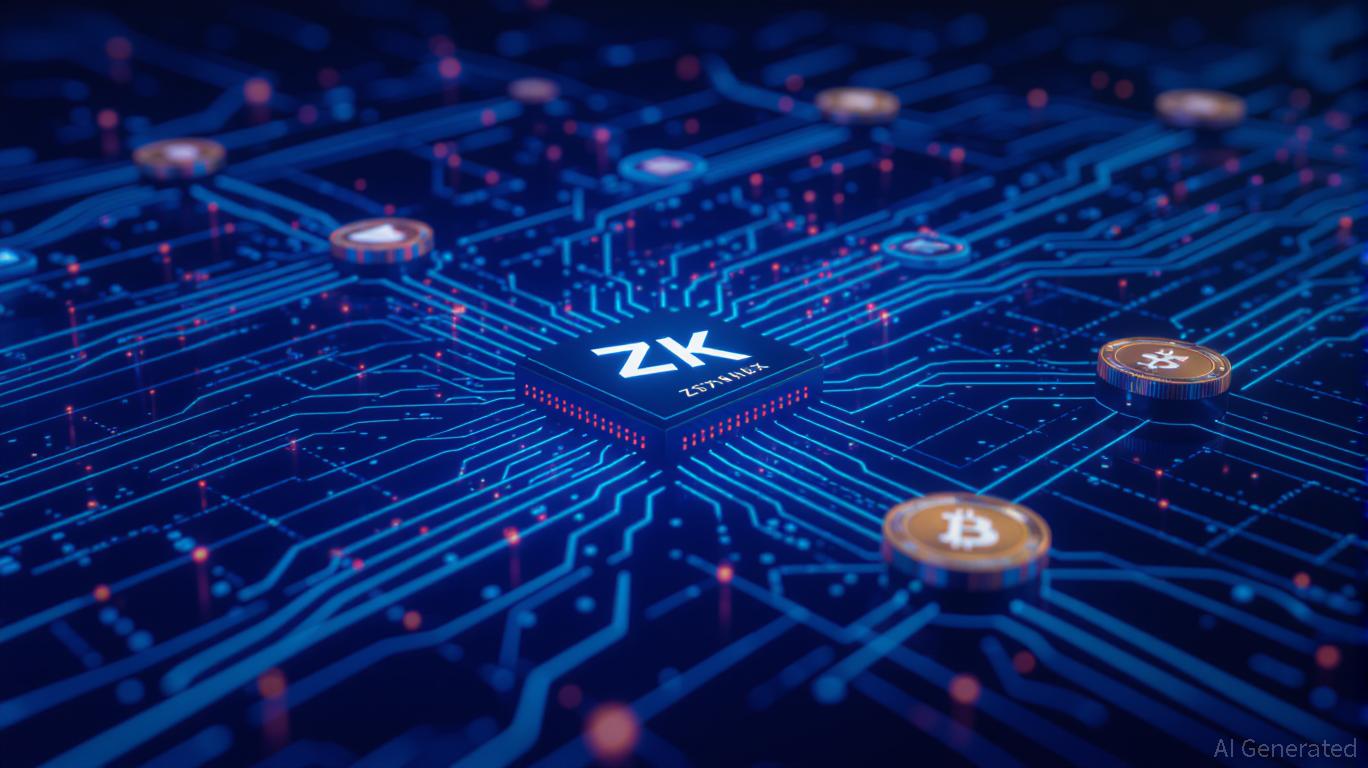Why ZK Coins Are Experiencing a Surge in November 2025
- ZK coins surged in November 2025 as DeFi platforms adopted ZK infrastructure for scalability, privacy, and cost efficiency. - Platforms like Polygon zkEVM and zkSync reduced Ethereum gas fees by 90% while enabling thousands of transactions per second. - Institutional adoption (Deutsche Bank, Sony) and Zcash's 23% price jump highlighted ZK's role in bridging privacy-focused crypto with mainstream finance. - Technological breakthroughs in ZK scaling (50x cost reduction) and rising TVL ($72M BTC bridged to
ZK Infrastructure: The Foundation for DeFi’s Future Expansion
Zero-knowledge proofs, a cryptographic breakthrough that allows for secure and private transactions at scale, have become essential for DeFi platforms aiming to rival conventional financial institutions. Solutions like Polygon zkEVM and zkSync are at the forefront of this movement. For example, Polygon’s ZK-Rollup technology can cut
StarkNet, another platform built on ZK technology, utilizes STARKs (Scalable Transparent Arguments of Knowledge) to process transactions off-chain and submit proof of validity to Ethereum’s main network. This method not only boosts transaction throughput but also guarantees cryptographic privacy—an increasingly important feature for users concerned about surveillance and regulatory pressures, as mentioned in a

The ZK Coin Boom: Privacy, Scalability, and Institutional Interest
The recent upswing in ZK coins, especially Zcash (ZEC), is closely linked to the growing use of ZK infrastructure.
Growing institutional involvement has further boosted demand. For instance, Deutsche Bank and Sony have adopted ZK-rollup solutions to facilitate large-scale transactions in compliance with regulatory requirements, according to Bitget’s analysis. At the same time, platforms such as Aztec are utilizing ZK-Rollup technology to enable confidential DeFi transactions, ensuring privacy without compromising on verification, as highlighted in the Top 10 ZK Rollup Projects in 2025 report. These advancements indicate a maturing industry where ZK infrastructure is evolving from a technical enhancement to a strategic necessity for both DeFi and traditional financial institutions.
Innovation and Shifting Market Forces
The intersection of technological progress and institutional participation has created a positive feedback loop for ZK coins. Innovations in ZK scaling, such as improvements to Ethereum’s EVM, have slashed the costs of ZK-proofs by a factor of 50, enabling layer 2 solutions like Lighter to process over 24,000 transactions per second, as detailed in Bitget’s analysis. This enhanced scalability has made ZK-rollups a viable backbone for DeFi, drawing interest from both individual and institutional investors.
Additionally, the unique benefits of ZK coins are driving their integration into DeFi platforms. Zcash’s robust privacy features, for example, meet the rising demand for financial anonymity in an era marked by frequent data leaks and surveillance, as discussed in the
Conclusion: The Long-Term Outlook for ZK Coins
The sharp rise in ZK coins during November 2025 points to a larger movement: the widespread integration of ZK-based infrastructure within DeFi. As platforms such as
Disclaimer: The content of this article solely reflects the author's opinion and does not represent the platform in any capacity. This article is not intended to serve as a reference for making investment decisions.
You may also like
UAE’s Digital Dirham: Shaping a Diverse Future for International Finance
- UAE completes first government transaction using Digital Dirham CBDC via mBridge platform, settling in under two minutes. - Pilot by UAE Ministry of Finance and Dubai Department of Finance validates cross-border and domestic payment capabilities without intermediaries. - Officials highlight CBDC's role in enhancing financial transparency, reducing settlement times, and advancing UAE's fintech leadership goals. - Global CBDC adoption grows with 137 countries exploring digital currencies, as UAE plans phas

Yen-backed Stablecoin Initiative May Challenge the Dollar’s Leading Role in Digital Finance
- JPYC, Japan's yen-pegged stablecoin issuer, plans to allocate 80% of 10-trillion-yen token proceeds to JGBs, aiming to fill gaps left by BOJ's stimulus tapering. - The strategy could reshape Japan's bond market as BOJ reduces its 50% JGB ownership stake, with JPYC CEO predicting global adoption of stablecoin-driven government bond demand. - Japan's FSA supports innovation through sandbox programs, including a pilot with major banks , while regulators warn stablecoins might divert funds from traditional b

COAI's Unexpected Price Decline in Early November 2025: An Indicator of Fluctuations in the AI Industry
- Canaan Inc. (COAI) saw a sharp stock price drop in early November 2025 amid AI/crypto sector volatility driven by regulatory uncertainty and strategic shorting. - C3.ai's 54% YTD decline and exploration of a potential sale highlighted the sector's shift from speculative hype to earnings-focused scrutiny. - Gemini's poor Q3 earnings and Nano Labs' bond redemption signaled broader pessimism, amplifying COAI's 88% YTD valuation decline. - Analysts project 20% downside for AI sector valuations, emphasizing p

Dogecoin News Update: Poain Launches 'Stablecoin 2.0' Featuring AI-Powered Returns and Green Energy Infrastructure
- Poain BlockEnergy expanded its AI-powered staking platform to include USDT , offering stablecoin yield generation via smart contracts and a presale for its PEB token. - The platform uses renewable energy-powered AI algorithms to optimize staking returns, providing a low-risk alternative to traditional trading with flexible 2-10 day plans. - Users can withdraw or reinvest profits in multiple assets, while PEB’s presale roadmap projects a 300x price increase from $0.007 to $2.50, pending adoption and regul
